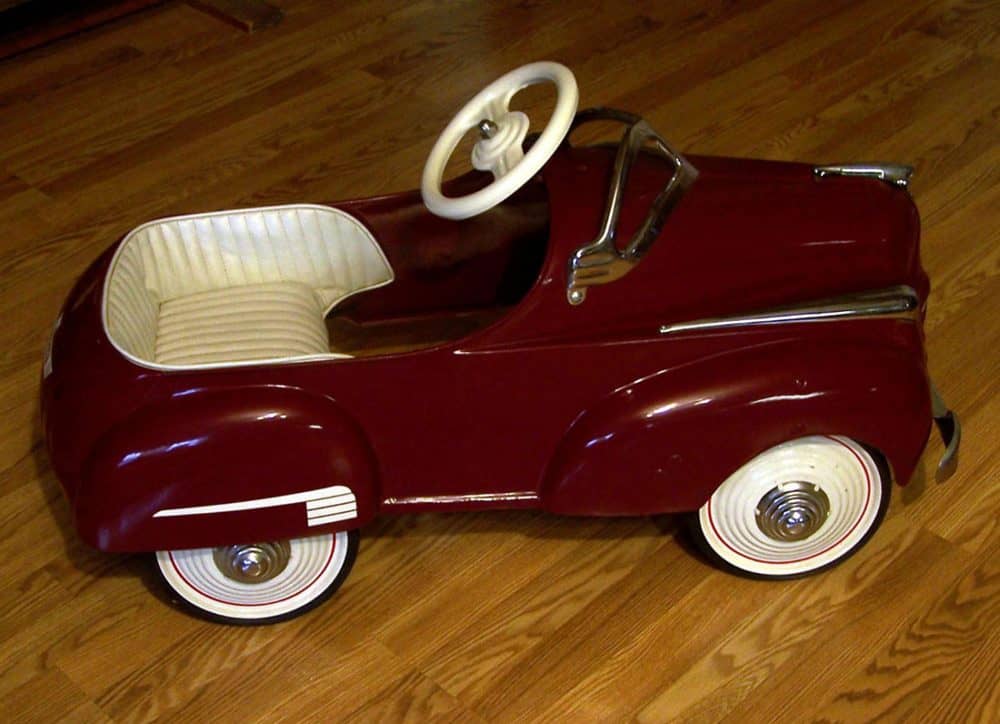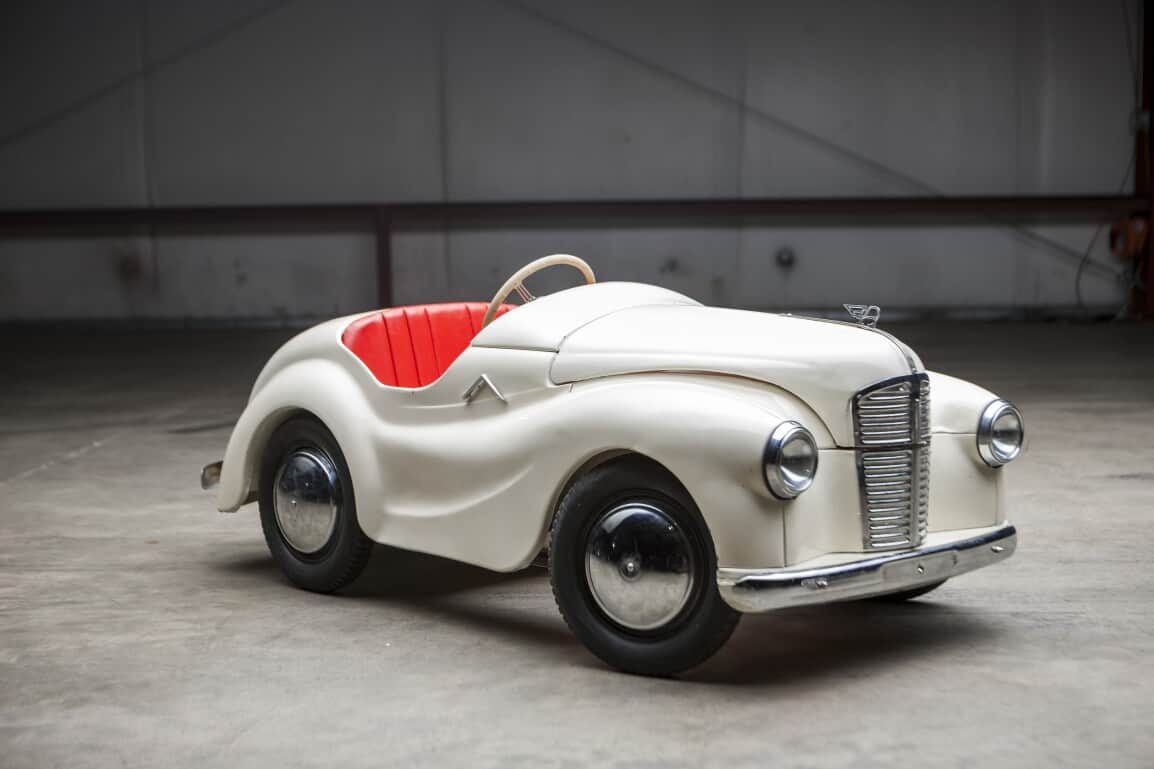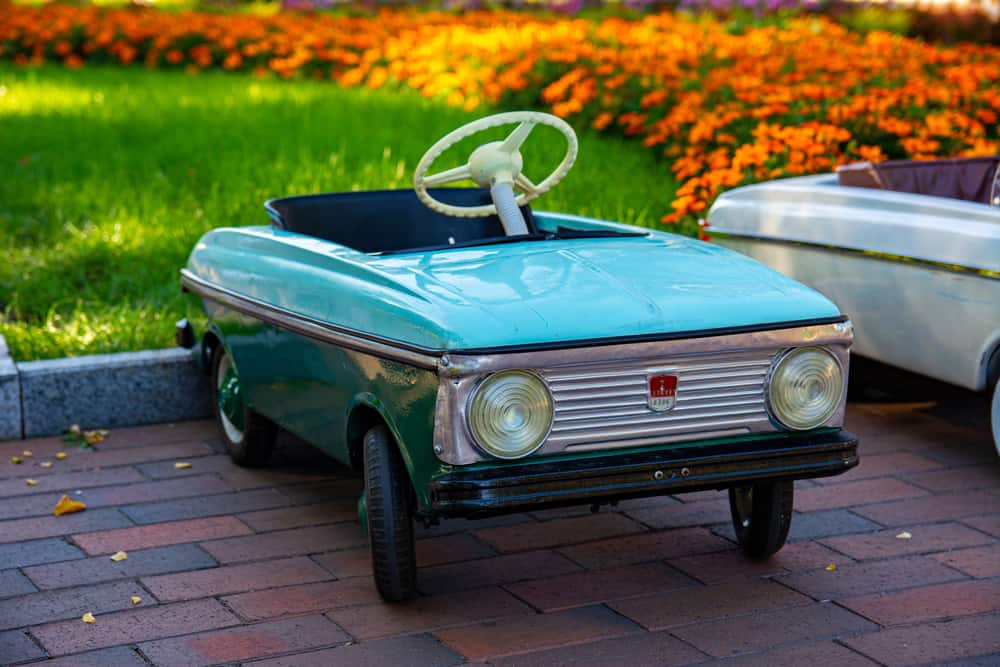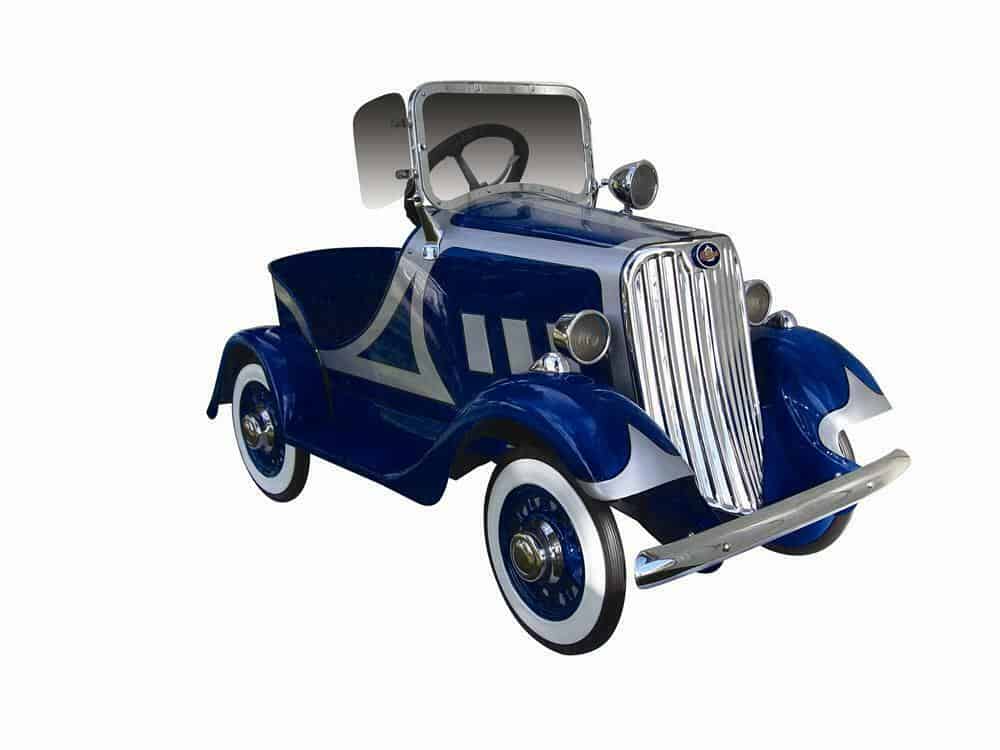Once considered the children’s ultimate riding toy, antique toy pedal cars are now only sought after by classic car enthusiasts and toy collectors. Their detailed appearance and brightly colored paint job make them a perfect gift for any occasion.
However, you might be wondering what the value of pedal cars is? Keep reading to find out everything you need to know about antique pedal cars and their value.
Table of Contents
History of Pedal Cars
The history of pedal cars dates back to the 1890s when they were modeled from real cars. Although every child wanted to own one, their cost meant that it was only for kids from wealthy families.
In the late 1920s and early 1930s, pedal cars peaked in popularity as the modern designs of cars were reproduced in the pedal cars. They were, however, still for upper-class children.
There was no production of pedal cars after the bombing of Pearl Harbor. This is because all medals were reserved for the war effort.
However, they experienced some resurgence with chain-driven models in the 1950s to 1960s. For instance, after the post- WorldWar prosperity in the 1950s, they grew more in popularity and were available in most major stores.
Therefore, from the early 1920s to the late 1960s, pedal cars were produced in many different colors and models. They were also designed to incorporate significant trends in the automotive world. For instance, they had the following features:
- Working lights and horns
- Whitewall tires
- Moveable windshields
- Chrome detailing and hood ornaments
- Custom paint job
When the burgeoning field of space exploration started to capture children’s attention in the 1960s, the interest in pedal cars began to wane. Besides, the new safety standards for children’s toys made them less cost-effective.
By the 1970s, plastic pedal toys, such as the Big Wheel, virtually put our pedal cars out of the market.
What is the Rarest Pedal Car?
One of the rarest pedal cars is the Striking 1935 Packard Deluxe pedal car. It has the following features:
- Size: 46 inches x 27 inches x 24 inches.
- Upholstered interior.
How do I Identify an Antique Toy Pedal Car?
If you are a collector, you will want to lay your hands on an antique toy pedal car. However, you must be asking yourself, how do I identify an antique toy pedal car?
You can use many things to identify an antique toy pedal car. These include:
The Materials Used
The older versions of antique pedal cars were made using cast iron. Cast iron is relatively affordable, and you can make it into nearly any shape.
Cast iron antique pedal cars contain some hand finishing and a lot of detail due to the painstakingly curved master molds. The master mold can be anything (brass, plaster, or wood).
However, it is vital to note that there are also newer pedal cars made from cast iron. Therefore, although it might be hard to tell them apart, antique pedal cars have finer details due to the casting sand. On the other hand, newer pedal car versions from the same materials have a more coarse feel.
The measurements of the pedal car
When an antique pedal car is replicated, it undergoes deformation, leading to loss of detail. For instance, even a slight deviation can significantly impact the final appearance of the pedal car.
So you can compare the measurements of the original pedal car and the test product if you know the exact measurements of the authentic original. To make the identification even more exact, you should use several volumes to provide the base tracing of the original product.
The Paint Used
The paint job can also be used to identify the new pedal car from an old pedal car. For instance, most vintage producers used a thick coat of oil-based enamel to finish their production. More recent productions use water-based acrylic paint.
Also, different application methods were used, thus affecting the final appearance of the pedal cars. For instance, older productions were dipped into the paint. The makers then use a brush to touch up some parts. In contrast, the newer productions use air-powered spray guns.
The Unpainted Condition
The older cast iron pedal car that has not been painted looks different from the newer cast iron pedal car. The newer pedal cars are often grey or have a dirty silver tint. On the other hand, the old pedal cars are dark brown or black. Still, you need to be cautious when you see an unpainted or colored production.
Nevertheless, some people can deceive you by altering the new pedal car paint and the exterior appearance. Besides, a dark-colored pedal car surface can be achieved by soaking it or burying a fresh bit in various chemicals. Furthermore, high temperatures can cause a new pedal car’s surface to turn a consistent deep or dull brown tone.
Therefore, you should check for repairs using a magnet. For example, most replacements and repairs are made of non-magnetic materials such as brass.
The Hand Finishing
The level of hand finishing is another difference between old and new antique toy pedal cars. For instance, most antique pedal cars have precise finishing while reproductions or duplicates do not. This is because the halves of original pedal cars were assembled by hand filling.
In earlier antique pedal cars, the attention to fit would have resulted in a tight seam. For instance, the seams of newer antique pedal cars are poorly constructed and frequently loose.
This is because the assembling method of pedal cars has been replaced with modern high-speed creation equipment. This equipment leaves visible grinding marks.
Hence if you notice these marks, especially if they are bright and discolored, you can conclude that the antique pedal car is a duplicate.
The Wear Pattern
In original painted antique pedal cars, the thicker paint layers formed to create a distinctive wear pattern. For instance, you will see sharp edge chips resulting from the thickness of the paint. Duplicate antique pedal cars do not have this wear pattern.
How to Restore an Antique Pedal Car

Before you start restoring your antique pedal car, it is vital to take detailed photos of every angle of the pedal car, especially the workings. This will assist you when attempting to remember how to put those parts back together.
Here is how you can restore an antique pedal car:
Step 1: Select the Antique Pedal Car
The first thing you need to do is select your antique pedal car. This is because there are many different antique pedal cars on the market. You can do a google image search for “antique pedal car,” and you will discover the extent of the available options.
You need to research the pedal car so that you do not get burned by an individual who bought a new reproduction of the pedal car, which will rust easily.
Step 2: Disassemble
Typically, the actual disassembling is not difficult. You can get most of the bolts open using pliers or WD-40. However, some need to be cut or drilled out using a Dremel cutting tool attachment.
It is important to keep all parts or hardware, regardless of whether they are damaged or not. If damaged, you can find their replacements at your local hardware store.
Step 3: Remove All the Old Rust and Paint
There are many ways that you can use to remove all the old rust and paint from the parts. For example, you can sand less rusty parts. Besides, you can strip the rust parts using chemical rust-eating agents.
The more significant parts, such as the body, need to be sand-blasted. This can be done by renting time at a booth. You can also have the body painted by a professional.
Step 4: Prime and powder-coat the parts
Since the parts are clean and stripped, you can prime them out. Besides, you need to powder-coat the moving parts. You should also have the internal parts power-coated by a professional. Powder-coating is tough and has a superb flawless finish.
The only downside of powder-coating is that you can only coat metals. For instance, the powder will not stick on fiberglass or any other type of filler.
Step 5: Paint the parts
You can do this using any of these three ways:
- Paint it yourself using spray cans
- Rent a spray booth
- Have it done by a professional
Step 6: Reassemble
This is where the photos come in hand, as they help you remember how to put the parts together.
Therefore, once you have painted the parts and replaced the damaged hardware, put the parts back together.
Antique Pedal Car Values
Antique toy pedal cars do not usually command the highest price, but the vintage releases might be just expensive. Typically, the value of a new antique toy pedal car with rubber tires, a wide front, and an excellent style can exceed $2000.
However, there are various factors that affect the value of antique and vintage pedal cars.
Factors That Affect the Antique Pedal Car Value
- The Condition of the Antique pedal car
No one would want to buy an antique pedal car that can not salvage, even if it was the most valued or priced item. This means that the condition of the antique pedal car will affect how much it will sell.
Many antique collectibles are easy to come by in damaged or worn forms. One in an undamaged condition is nearly rare to find. Therefore, an antique pedal car in perfect condition will attract a far greater price.
- The Rarity of the Antique Pedal Car
Antique pedal cars that are rare to come by have more value than those you can easily find everywhere.
Although not all old antique toy pedal cars are helpful, a few could sell for an impressive amount. For instance, the valuable ones are probably those made with specific materials and by a particular manufacturer.
- Date of Production
Antique toy pedal cars manufactured in a certain period will attract more attention than others. So you need to check for the production date of these toys. You can do this by trying to discover their origin or looking for a marking on the toys.
How to Value and Sell Antique Toy Pedal Cars

Antique toy pedal cars are difficult to evaluate since their value depends on factors one is willing to pay for.
There are different ways to determine the value of an antique toy pedal car. They include:
- Check the recent sales of similar antique toy pedal cars
The best way to determine the value of your antique pedal car is to check the prices of similar products recently sold. You can do this using eBay’s advanced search. It will be vital to inquire about the date and variances between your antique toy and those posted.
- Adjust your pricing according to the quality of the antique pedal car
The quality of your antique toy pedal car compared to similar sold toys can be vital in evaluating your antique toy.
If your antique pedal car is in better shape and quality than what is sold on eBay, the buyer will likely be willing to pay more. As a result, you can increase its price. Also, if your antique pedal car is a more limited edition, you can raise the price.
- Get more resourceful information about antique pedal cars’ value
You will also require resourceful information to value your antique pedal car. The more information you get, the more reliable and accurate your valuation.
You can use the internet since it is free and it will give you a lot of resourceful information on what you are looking for. Besides, you can use publications and books. Generally, books are very detailed, and they include a lot of high-quality images for identification and valuation.
Conclusion
An antique toy pedal car is not just any old thing; it is among the most prized and valuable possessions. They are also highly sought after. Therefore, if you plan to sell your antique pedal car, ensure you understand its exact value.
I hope the tips in this article were of great help. If you have comments, questions, or suggestions, let us know about them in the comments section below.

